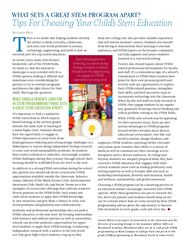
Return to flip book view
WHAT SETS A GREAT STEM PROGRAM APART?Tips For Choosing Your Child’s Stem EducationFrom kindergarteners tinkering, to seniors doing biology research, students should have the opportunity to engage in STEM experiences at every level.By Connie WhiteThere is no doubt that helping students develop the ability to think critically, collaborate, and solve real-world problems in science, technology, engineering, and math is now an essential part of a top-notch education.In recent years, many schools have heeded the call of the STEM fields. So much so, that the education landscape is now crowded with K-12 STEM options, making it difficult and sometimes even overwhelming for parents to try to evaluate programs and discern the right choice for their child. This begs the question:WHAT SHOULD PARENTS LOOK FOR IN STEM PROGRAMMING? WHAT SETS A GREAT STEM EDUCATION APART?It’s important to find a cumulative STEM curriculum in which inquiry-based learning in the earliest grades informs the same style of learning at a much higher level. Students should have the opportunity to engage in STEM experiences at every level, from kindergarteners tinkering and solving design challenges in a MakerSpace to seniors doing independent biology research to solve real-world sustainability problems. As students find creative solutions to authentic, increasingly complex STEM challenges during their journey through school, their learning should be scaffolded from one level to the next.In addition to a strong STEM curriculum during the school day, parents also should ask about cocurricular STEM opportunities available outside the classroom. Robotics teams, Odyssey of the Mind, Science Club, Environmental Awareness Club, Math Lab, and Drone Teams are a few examples of cocurricular offerings that cultivate students’ diverse passions in the STEM fields. Such teams and clubs allow students to apply their STEM knowledge in new situations and give them a chance to solve real-world problems independently and collaboratively.Academic and professional partnerships also can push a STEM education to the next level. By forming relationships with business and industry partners as well as universities, schools can provide authentic opportunities for upper-level students to apply their STEM learning. Conducting independent research with a mentor in the real world not only gives high-school students a leg up as they head into college, but also provides valuable experience that will inform students’ careers. Students also benefit from having to demonstrate their learning to external audiences, and STEM experts in the broader community can help augment and assess students’ research in a real-world setting.Parents also should inquire about STEM-related professional development for faculty and staff. It’s a tremendous sign of a school’s commitment to STEM when teachers have plans for their own personal growth and actively seek out opportunities to explore their STEM-related passions, strengthen their skills, and find innovative ways to incorporate technology into the classroom. When faculty and staff are truly invested in STEM, they engage students in an organic way, genuinely fostering critical thinking and ethical problem solving in the STEM fields.While STEM-only schools may be appealing for their intensive focus, there are also serious advantages to STEM programs housed within a broader, more diverse educational environment. Just like real-world scientists, design-thinkers, and engineers, STEM students operating within a broader curriculum must translate their skills to a variety of media as well as communicate their learnings across disciplines and to diverse audiences. In college and beyond, students are uniquely prepared when they have received a STEM education that engages with other critical academic areas such as reading proficiency and writing expertise as well as broader skill sets such as leadership development, diversity and inclusion, health and wellness, sustainability, and global awareness.Choosing a STEM program can be a daunting process in an education market increasingly saturated with STEM options. While these guidelines are sure to winnow the list, above all, parents and students should keep an eye out for schools where kids are truly excited by their STEM programming and are given the opportunity to harness that excitement in every grade, each and every day. Connie White is an expert in innovation in the classroom and the Director of Learning Design in the Academic Affairs Office at Woodward Academy. Woodward offers pre-K to 12th grade STEM programming at Main Campus in College Park and pre-K to 6th grade STEM programming at Woodward North in Johns Creek.